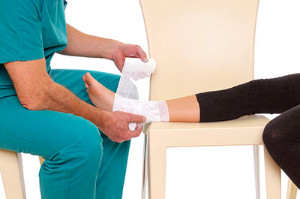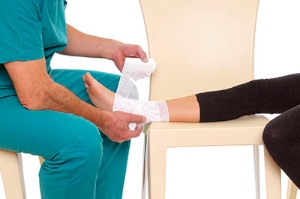
Bunions
A bunion is a bump that forms at the base of the big toe. Bunions form when the big toe pushes against the next toe, which forces the big toe joint to get bigger and stick out. As a result, the skin over the bunion may start to appear red and it may feel sore.
There are risk factors that can increase your chances of developing bunions. People who wear high heels or ill-fitting shoes are more likely to develop them, in addition to those who have a genetic history of bunions or have rheumatoid arthritis.
The most obvious way to tell if you have a bunion is to look for the big toe pushing up against the toe next to it. Bunions produce a large protrusion at the base of the big toe and may or may not cause pain. Other symptoms are redness, swelling, and restricted movement of the big toe if you have arthritis.
Nonsurgical methods are frequently used to treat bunions that aren’t severe. Some methods of nonsurgical treatment are orthotics, icing and resting the foot, taping the foot, and pain medication. Surgery is usually only required in extreme cases. However, if surgery is needed, some procedures may involve removing the swollen tissue from around the big toe joint, straightening the big toe by removing part of the bone, or joining the bones of your affected joint permanently.
Your podiatrist will diagnose your bunion by doing a thorough examination of your foot. He or she may also conduct an x-ray to determine the cause of the bunion and its severity.
Ankle Sprains and Fractured Ankles
 There are many reasons why ankle pain may exist. It is considered to be a common injury, and the type of ankle pain can range from a severe sprain to a broken ankle. It can occur as a result of suddenly stepping off of a curb and twisting the ankle, or from participating in certain sporting activities. The tendons in the ankle help to make it possible to walk and run, and if these become torn or stretched, severe pain and discomfort may occur. Once a proper diagnosis is performed, the correct treatment can begin. Moderate relief may be found when the affected ankle is elevated, which may help to alleviate existing swelling. When the ankle is wrapped in an elastic bandage, the foot may feel adequately supported. If you have fallen and your ankle is affected, please speak with a podiatrist who can guide you toward proper healing treatments.
There are many reasons why ankle pain may exist. It is considered to be a common injury, and the type of ankle pain can range from a severe sprain to a broken ankle. It can occur as a result of suddenly stepping off of a curb and twisting the ankle, or from participating in certain sporting activities. The tendons in the ankle help to make it possible to walk and run, and if these become torn or stretched, severe pain and discomfort may occur. Once a proper diagnosis is performed, the correct treatment can begin. Moderate relief may be found when the affected ankle is elevated, which may help to alleviate existing swelling. When the ankle is wrapped in an elastic bandage, the foot may feel adequately supported. If you have fallen and your ankle is affected, please speak with a podiatrist who can guide you toward proper healing treatments.
Foot and ankle trauma is common among athletes and the elderly. If you have concerns that you may have experienced trauma to the foot and ankle, consult with one of our podiatrists from Summit Podiatry. Our doctors will assess your condition and provide you with quality foot and ankle treatment.
Foot and ankle trauma cover a range of injuries all over the foot; common injuries include:
- Broken bones
- Muscle strains
- Injuries to the tendons and ligaments
- Stress fractures
Symptoms
Symptoms of foot and ankle injuries vary depending on the injury, but more common ones include:
- Bruising
- Inflammation/ Swelling
- Pain
Diagnosis
To properly diagnose the exact type of injury, podiatrists will conduct a number of different tests. Some of these include sensation and visual tests, X-rays, and MRIs. Medical and family histories will also be taken into account.
Treatment
Once the injury has been diagnosed, the podiatrist can than offer the best treatment options for you. In less severe cases, rest and keeping pressure off the foot may be all that’s necessary. Orthotics, such as a specially made shoes, or immobilization devices, like splints or casts, may be deemed necessary. Finally, if the injury is severe enough, surgery may be necessary.
If you have any questions, please feel free to contact one of our offices located in Wilmington, Whiteville, and Wallace, NC . We offer the newest diagnostic and treatment technologies for all your foot care needs.
Foot and Ankle Trauma
The foot and ankle area works with 26 bones, 33 joints, and more than 100 different muscles, tendons, and ligaments. Problems with any parts of this network can result in some kind trauma within the foot and ankle area. Most foot and ankle trauma is a result of aging or intense activities such as sports. However, trauma in this area can also be the result of simple things such as wearing heels too much or even walking on an uneven pavement. There are several kinds of symptoms related to specific injuries, and there are also several different treatments that could be used as well.
Foot Injuries and Symptoms
Some common injuries in the feet include stress fractures and bunions. Stress fractures are small cracks in a bone or severely bruised parts of the bone. This type of injury is caused by intense and repetitive activity, which is found in actions involved with sports and exercise. Symptoms of this injury include pain, swelling, tenderness, and possible bruising. Another common injury with bones is also bunions, which are bony bumps typically formed on the big and little toes. This injury is typically a result from wearing high heels and unfit shoes. Some common symptoms are swelling around the big and little toe areas, as well as pain and restricted movement.
Ankle Injuries and Symptoms
The common injuries associated with ankle trauma consist of sprains, strains, and fractures. These injuries are defined by the type of tissue that has been damaged. Fractures are breaks within the bones caused by sudden impacts to the area. Sprains relate to any damage of the ligaments, commonly caused by being stretched beyond their normal range of motion. Strains are attributed to damage of the muscles and tendons from being pulled too far. Symptoms of these injuries include severe pain, limited range of motion, and swelling.
Diagnosis and Treatment
Since there are several types of injuries with a variety of symptoms, it is important to see a podiatrist about your condition. Podiatrists can run a variety of tests to diagnose an injury accurately. This includes physical examinations, X-rays, or MRIs. A podiatrist may even run a stress test, which is an X-ray taken while pressure is applied to the damaged area. Once your injury has been diagnosed, the doctor may have you wear a cast or a splint, or gradually develop your range of motion. Severe injuries may require physical therapy or even surgery if necessary. If you have any concerns from past foot and ankle trauma experiences, consult with one of our podiatrists from Summit Podiatry. Our doctors can assess your condition and provide you with quality foot and ankle treatment.
If you have any questions, please feel free to contact one of our offices located in Wilmington, Whiteville, and Wallace, NC . We offer the newest diagnostic and treatment technologies for all your foot care needs.
Possible Foot Conditions Affecting Diabetic Patients
Research has indicated that there are two ailments that may develop as a result of being diabetic.These conditions are known as peripheral artery disease (PAD), and peripheral neuropathy. Both of these can accelerate the risk of foot problems in diabetic patients as a result of potential nerve damage. Additional foot problems that can happen from being diabetic can include fungal infections, ingrown toenails, or bunions. Diabetes can occur if the glucose levels in the blood become elevated, and can possibly be controlled when foods that are eaten contain minimal sugar. If you are a diabetic patient, it is strongly advised that you are under the care of a podiatrist who can help you to manage this potentially dangerous condition.
Diabetic foot care is important in preventing foot ailments such as ulcers. If you are suffering from diabetes or have any other concerns about your feet, contact one of our podiatrists from Summit Podiatry. Our doctors can provide the care you need to keep you pain-free and on your feet.
Diabetic Foot Care
Diabetes affects millions of people every year. The condition can damage blood vessels in many parts of the body, especially the feet. Because of this, taking care of your feet is essential if you have diabetes, and having a podiatrist help monitor your foot health is highly recommended.
The Importance of Caring for Your Feet
- Routinely inspect your feet for bruises or sores.
- Wear socks that fit your feet comfortably.
- Wear comfortable shoes that provide adequate support.
Patients with diabetes should have their doctor monitor their blood levels, as blood sugar levels play such a huge role in diabetic care. Monitoring these levels on a regular basis is highly advised.
It is always best to inform your healthcare professional of any concerns you may have regarding your feet, especially for diabetic patients. Early treatment and routine foot examinations are keys to maintaining proper health, especially because severe complications can arise if proper treatment is not applied.
If you have any questions please feel free to contact one of our offices located in Wilmington, Whiteville, and Wallace, NC . We offer the newest diagnostic and treatment technologies for all your foot and ankle needs.
Diabetic Foot Care
Diabetes can cause two problems that can potentially affect the feet: Diabetic neuropathy and Peripheral Vascular Disease. Diabetic neuropathy occurs when nerves in your legs and feet become damaged, which prevents you from feeling heat, cold, or pain. The problem with diabetic neuropathy is that a cut or sore on the foot may go unnoticed and the cut may eventually become infected. This condition is also a main cause of foot ulcers. Additionally, Peripheral vascular disease also affects blood flow in the body. Poor blood flow will cause sores and cuts to take longer to heal. Infections that don’t heal do to poor blood flow can potentially cause ulcers or gangrene.
There are certain foot problems that are more commonly found in people with diabetes such as Athlete’s foot, calluses, corns, blisters, bunions, foot ulcers, ingrown toenails, and plantar warts. These conditions can lead to infection and serious complications such as amputation. Fortunately, proper foot care can help prevent these foot problems before they progress into more serious complications.
Each day you should wash your feet in warm water with a mild soap. When you finish washing your feet, dry them carefully especially between your toes. You should also perform daily foot inspections to ensure you don’t have any redness, blisters, or calluses. Furthermore, if you are diabetic, you should always wear closed-toed shoes or slippers to protect your feet. Practicing these tips will help ensure that your feet are kept healthy and away from infection.
If you have diabetes, contact your podiatrist if you have any of the following symptoms on your feet: changes in skin color, corns or calluses, open sores that are slow to heal, unusual and persistent odor, or changes in skin temperature. Your podiatrist will do a thorough examination of your feet to help treat these problematic conditions.
Swollen Feet During Pregnancy
 It is common knowledge that pregnant women have swollen feet. This typically occurs in the second trimester, and can be a result of hormonal changes, the growing fetus, and lifestyle habits. Research has indicated mild relief may be found when the feet are elevated as frequently as possible, and eating foods that have limited sodium. Additionally, it is beneficial to wear comfortable shoes, and to practice gentle stretching during the day. Some of these stretches can include rotating the ankles, pointing and flexing the feet, and it may help to refrain from crossing your ankles. If you would like additional information about the impact pregnancy may have on the feet, please consult with a podiatrist.
It is common knowledge that pregnant women have swollen feet. This typically occurs in the second trimester, and can be a result of hormonal changes, the growing fetus, and lifestyle habits. Research has indicated mild relief may be found when the feet are elevated as frequently as possible, and eating foods that have limited sodium. Additionally, it is beneficial to wear comfortable shoes, and to practice gentle stretching during the day. Some of these stretches can include rotating the ankles, pointing and flexing the feet, and it may help to refrain from crossing your ankles. If you would like additional information about the impact pregnancy may have on the feet, please consult with a podiatrist.
Pregnant women with swollen feet can be treated with a variety of different methods that are readily available. For more information about other cures for swollen feet during pregnancy, consult with one of our podiatrists from Summit Podiatry. Our doctors will attend to all of your foot and ankle needs.
What Foot Problems Can Arise During Pregnancy?
One problem that can occur is overpronation, which occurs when the arch of the foot flattens and tends to roll inward. This can cause pain and discomfort in your heels while you’re walking or even just standing up, trying to support your baby.
Another problem is edema, or swelling in the extremities. This often affects the feet during pregnancy but tends to occur in the later stages.
How Can I Keep My Feet Healthy During Pregnancy?
- Wearing orthotics can provide extra support for the feet and help distribute weight evenly
- Minimize the amount of time spent walking barefoot
- Wear shoes with good arch support
- Wear shoes that allow for good circulation to the feet
- Elevate feet if you experience swelling
- Massage your feet
- Get regular, light exercise, such as walking, to promote blood circulation to the feet
If you have any questions please feel free to contact one of our offices located in Wilmington, Whiteville, and Wallace, NC . We offer the newest diagnostic and treatment technologies for all your foot and ankle needs.
Foot Care for Pregnant Women
The natural weight that pregnant women gain causes their center of gravity to be completely altered. This causes them to have a new weight-bearing stance which adds pressure to the knees and feet. As a result, pregnant women often experience severe foot pain. The two most common foot issues experienced by women in their pregnancies are edema and over-pronation. It is important for all pregnant women to learn more about how to take care of their feet so they are more comfortable during their pregnancy.
Over-pronation, which is commonly referred to as flat feet, is caused when a person’s arch flattens out upon weight bearing. This causes the person’s feet to roll inward while walking. Pregnant women often experience this due to the sudden weight they gain.
Edema, also referred as swelling in the feet, typically occurs in the later part of the pregnancy. It is the result of the extra blood accumulated in the pregnant woman’s body. The enlarged uterus puts more pressure on the blood vessels in the pelvis which causes leg circulation to slow down. This causes blood to pool in the lower extremities.
Fortunately, there are ways to treat both edema and over-pronation. Edema can be treated by elevating the foot as often as possible. Wearing proper fitting footwear will also be helpful for those with edema. A treatment method for over-pronation could be orthotics. Orthotic inserts should be designed with appropriate arch support and medial rear foot for your foot.
It is best for pregnant women to buy new shoes during the day, because this is the time where swelling is at its peak. Pregnant women also shouldn’t rush when buying shoes. It is always advised that you make sure your shoes fit properly but this is especially important during pregnancy.
If you are a pregnant woman, you should consult with a podiatrist in order to make sure your feet are healthy throughout the entirety of your pregnancy.
How to Best Treat a Toenail Infection
 Nail fungus, typically picked up from not wearing the proper footwear in communal showers, locker rooms, and swimming pools, is contagious and can lead to a great deal of pain if left untreated. When the fungus gets under the nail, it will likely cause the toenail to thicken, harden, and become discolored. The nail may also become brittle and fall off. Those with diabetes, circulatory issues, or an immune deficiency are more likely to develop a toenail fungus infection. Your chances of getting an infection may also increase with age. As far as treating the infection, we recommend you see a podiatrist as soon as possible for a physical exam, as well as to get a sample of your nail tested to determine if the infection truly is fungal. Once diagnosed, a podiatrist may suggest oral treatments, topical treatments, laser treatments, or for more severe cases, surgical treatments. For professional care and an advised treatment plan, we recommend you consult with a podiatrist as soon as possible.
Nail fungus, typically picked up from not wearing the proper footwear in communal showers, locker rooms, and swimming pools, is contagious and can lead to a great deal of pain if left untreated. When the fungus gets under the nail, it will likely cause the toenail to thicken, harden, and become discolored. The nail may also become brittle and fall off. Those with diabetes, circulatory issues, or an immune deficiency are more likely to develop a toenail fungus infection. Your chances of getting an infection may also increase with age. As far as treating the infection, we recommend you see a podiatrist as soon as possible for a physical exam, as well as to get a sample of your nail tested to determine if the infection truly is fungal. Once diagnosed, a podiatrist may suggest oral treatments, topical treatments, laser treatments, or for more severe cases, surgical treatments. For professional care and an advised treatment plan, we recommend you consult with a podiatrist as soon as possible.
For more information about treatment, contact one of our podiatrists of Summit Podiatry. Our doctors can provide the care you need to keep you pain-free and on your feet.
Toenail Fungus Treatment
Toenail fungus is a condition that affects many people and can be especially hard to get rid of. Fortunately, there are several methods to go about treating and avoiding it.
Antifungals & Deterrence
Oral antifungal medicine has been shown to be effective in many cases. It is important to consult with a podiatrist to determine the proper regiment for you, or potentially explore other options.
Applying foot powder on the feet and shoes helps keep the feet free of moisture and sweat.
Sandals or open toed shoes – Wearing these will allow air movement and help keep feet dry. They also expose your feet to light, which fungus cannot tolerate. Socks with moisture wicking material also help as well.
If you have any questions please feel free to contact one of our offices located in Wilmington, Whiteville, and Wallace, NC . We offer the newest diagnostic tools and technology to treat your foot and ankle needs.
Treating Toenail Fungus
Fungal infection of the toenail, or onychomycosis, typically appears as a gradual change in a toenail’s texture and color that involves brittleness and darkening. The fungal infection itself occurs beneath the surface of the nail. Aside from discoloration, other symptoms include the collection of debris beneath the nail plate, white marks on the nail plate, and a foul odor emanating from the nail. If ignored, the infection can spread into other nails and the skin; in severe cases, it can hinder one’s ability to work or walk.
The toenails are particularly vulnerable to contracting infection in moist environments where people are likely to be walking barefoot, such as around swimming pools, public showers, and locker rooms. Fungal infection may also be more likely to occur in nail beds that have been injured, and sufferers of chronic diseases such as diabetes, circulatory problems, or immunodeficiency conditions are particularly prone to developing fungal nails.
Fungal nails can be primarily prevented by practicing proper hygiene and regularly examining the feet and toes. Carefully washing the feet with soap and water and thoroughly drying the feet afterwards are essential. Other tips include wearing shower shoes in public areas, changing shoes and socks daily, keeping toenails clipped at a short length, wearing breathable shoes that fit properly, wearing moisture-wicking socks, and disinfecting home pedicure tools and instruments used to cut nails.
Fungal nail treatment may vary between patients and the severity of the condition. Your podiatrist may suggest a daily routine of cleansing that spans over a period of time to ease mild infections. Over-the-counter or prescription antifungal agents may also be prescribed, including topical and/or oral medications. Debridement, or the removal of diseased nail matter and debris, may also be performed. In more severe cases, surgical treatment may be needed. In some instances, the temporary removal of the fungal nail allows for the direct application of a topical antifungal to the nail bed. In other cases, a chronically painful fungal nail that has not responded to other treatments may be permanently removed; this allows the infection to be cured and avoids the growth of a deformed nail.
Poor Blood Circulation in Your Legs and Feet

Circulatory problems in the legs and feet can occur simply from sitting or standing in the same position for a prolonged time or not moving your toes enough. Unfortunately, this can lead to blood clots or deep vein thrombosis – two possibly fatal conditions. Poor blood circulation can also result from thickened arteries caused by age, family history, diabetes, or high cholesterol. A healthy diet and regular exercise (including wiggling your toes and rotating your ankles daily) are the best things you can do to improve your chances of good blood flow to your lower extremities. Signs that you may be suffering from poor circulation can include numbness, tingling, pain in your feet, cold toes or fingers, and/or pale or blue-tinged skin. If you suspect you have poor circulation, speak to a podiatrist about solutions and treatment available.
While poor circulation itself isn’t a condition; it is a symptom of another underlying health condition you may have. If you have any concerns with poor circulation in your feet contact one of our podiatrists of Summit Podiatry. Our doctors will treat your foot and ankle needs.
Poor Circulation in the Feet
Peripheral artery disease (PAD) can potentially lead to poor circulation in the lower extremities. PAD is a condition that causes the blood vessels and arteries to narrow. In a linked condition called atherosclerosis, the arteries stiffen up due to a buildup of plaque in the arteries and blood vessels. These two conditions can cause a decrease in the amount of blood that flows to your extremities, therefore resulting in pain.
Symptoms
Some of the most common symptoms of poor circulation are:
- Numbness
- Tingling
- Throbbing or stinging pain in limbs
- Pain
- Muscle Cramps
Treatment for poor circulation often depends on the underlying condition that causes it. Methods for treatment may include insulin for diabetes, special exercise programs, surgery for varicose veins, or compression socks for swollen legs.
As always, see a podiatrist as he or she will assist in finding a regimen that suits you. A podiatrist can also prescribe you any needed medication.
If you have any questions, please feel free to contact one of our offices located in Wilmington, Whiteville, and Wallace, NC . We offer the newest diagnostic and treatment technologies for all your foot care needs.






